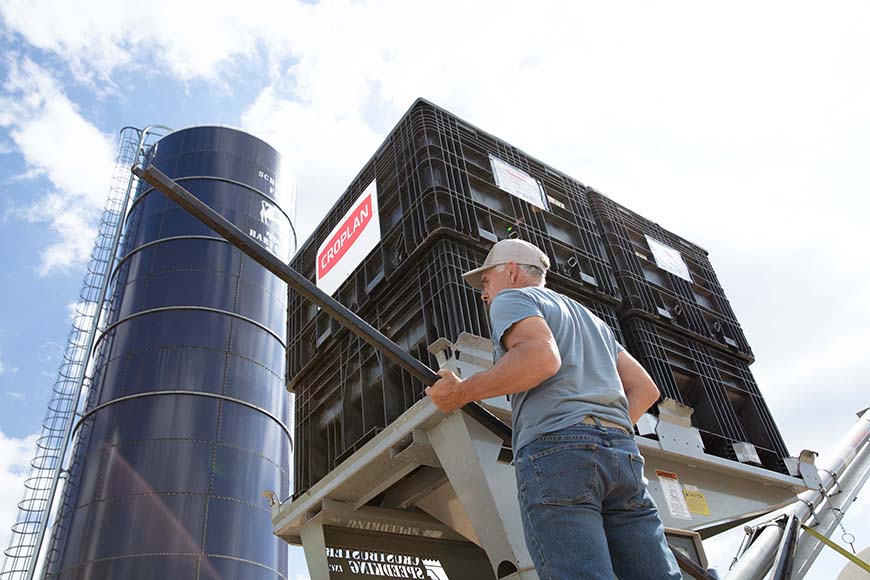3 Management Considerations for Corn-on-Corn Acres
Andy Dickes
Seed Product Manager

To maximize yield potential in corn-on-corn acres, additional management considerations are needed. Whether it’s adjusting your fertility program or managing crop residue, even small changes to your plan could have significant impacts. Here are three considerations to help optimize the ROI potential of your corn-on-corn acres.
Manage crop residue
One of the biggest challenges for non-rotational corn acres is crop residue. Without proper management, the extra plant debris in fields causes soil to remain cooler and wetter, and can contribute to reduced seed-to-soil contact. These situations can lead to poor or uneven plant emergence but there are several options to help prevent this, including various tillage methods, baling off plant debris in the fall and using a row cleaner on your planter. Planting into a clean furrow will help get your crops off to a stronger start, and that can lead to season-long benefits.
Apply plenty of nitrogen
Nitrogen management is critical to ensure your hybrids have what they need to meet their yield potential. When crops aren’t rotated with soybeans, they lose the nitrogen credits that legumes may offer.
An important part of managing nitrogen in corn is understanding how you can make it available at the soil and root interface at the right time physiologically so the crop can access it when needed. There are many strategies your agronomist can recommend to help with this, such as utilizing of a variety of N sources, making multiple applications at various timings, or employing the proper nitrogen stabilizer to fit each N source and application technique. Make sure you work with your agronomist to determine which of these practices may best fit your field and operation.
For corn-on-corn acres, it’s also a good idea to select hybrids with low response-to nitrogen (RTN) scores. This indicates their yield performance is not as dependent on nitrogen as others.
In season, keep an eye on potassium and sulfur levels as well. According to NutriSolutions® tissue test data, late-season deficiencies in both nutrients were common in 2021. This is especially important because sulfur and potassium are essential for increasing nitrogen use efficiency. To convert nitrogen to protein in the plant, it needs adequate potassium and sulfur. For high-yielding crops, a 10:1 ratio of nitrogen to sulfur is ideal and a ratio of 1.4:1 of N:K is needed. MAX-IN® Sulfur and MAX-IN K are foliar-applied nutrients that can help supplement tissue-deficient crops to promote effective nitrogen utilization.
Choose the right seed
Yield potential begins with choosing the right seed. When you have a limited crop rotation, there are even more factors that weigh into your decision. Since corn rootworms are more problematic in corn-on-corn acres, you’ll want to be sure the hybrids you choose offer adequate protection against the pest. Stacked insect traits like the new SmartStax® PRO with RNAi technology that protect against both above- and below-ground pests are worth the investment. If you’ve noticed heavy corn rootworm pressure in your fields, you may want to consider rotating to another crop or applying an in-furrow insecticide to manage larvae populations.
Beyond the trait package, you’ll also want to consider a hybrid’s genetics. It’s a good idea to choose hybrids with more tolerance to diseases, including Goss’s wilt, gray leaf spot and northern corn leaf blight. Those pathogens can overwinter on corn residue, which increases the disease inoculum in the soil and makes crops more susceptible to infection.
Like RTN scores, there are also response-to continuous corn (RTCC) scores, which indicate how a hybrid responds to the tougher environments of corn-on-corn acres. Hybrids with a higher RTCC score not only perform better in continuous corn fields, they also tend to tolerate colder soil conditions better than those with a lower RTCC score and have better emergence potential, even in tougher environments.
As you head into a new growing season, remember to scout fields early and often to identify any in-season agronomic challenges that could affect ROI potential. For more information on managing your corn-on-corn acres, contact your local WinField® United retailer.
All photos are either the property of WinField United or used with permission.
© 2022 WinField United. Important: Before use always read and follow label instructions. Crop performance is dependent on several factors many of which are beyond the control of WinField United, including without limitation, soil type, pest pressures, agronomic practices and weather conditions. Growers are encouraged to consider data from multiple locations, over multiple years and to be mindful of how such agronomic conditions could impact results. NutriSolutions, MAX-IN and WinField are trademarks of WinField United. All other trademarks are the property of their respective owners.
IF YOU LOVE OUR INSIGHT, YOU’LL LOVE OUR ROI POTENTIAL
Every successful harvest starts with a seed. It just can't end there. Choose which high-performing seed products you’ll start with this season.




